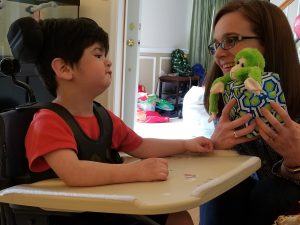 In trying to find a book that Joey may find engaging, I grabbed It’s Not Easy Being a Bunny by Marilyn Sadler. This is one of those books I’d never classify as quality children’s literature, but it has all the right elements to be an engaging read aloud for the four through six year old crowd.
In trying to find a book that Joey may find engaging, I grabbed It’s Not Easy Being a Bunny by Marilyn Sadler. This is one of those books I’d never classify as quality children’s literature, but it has all the right elements to be an engaging read aloud for the four through six year old crowd.
- It has a relatable storyline – someone who doesn’t quite fit into his family, or someone who just wants to see what life is like being someone else
- It has repetitive, predictable text, where the reader lists all the animals P.J. Funny Bunny does not want to be. This makes it easy for children to join into the read aloud experience, either verbally or non-verbally
- It is four and five year old sense of humor funny. A bunny trying to be a possum? Too silly. But the humor does not involve needing to make inferences or understand that characters have two different ideas.
- It involves bad body odor (from a skunk, or course)
- Its characters are common storybook animals
- It has simple, bright pictures without too much detail
To make this as engaging as possible for Joey while he does not have his device, I gathered toy animals to represent each animal in the book (except the possum. I don’t have a stuffed possum. I don’t think TY ever made one in Beanie Baby form, but I could be wrong.) Lately Joey’s taken to sifting through my bin of animals in order to select each one as we come to that page in the book. He likes to be presented with multiple choices of animals, and then dig through to find the correct animal. This is a change in our practice, from when I’ve just handed him the animal, or when he chose between two animals I held up. As his motor skills are increasing I suspect he likes the challenge and the independence, as well as the opportunity to think through which animal he needs.
In addition to using the physical toy representations of the animals, I also laminated clip art pictures of the animals and put velcro on the back so that Joey could take the pictures on and off his tray. This also makes it easy for us to line up the animals, count them, and use the pictures to tell number stories. Just like with the toys, Joey now likes to be presented with all of the choices. He scans his options, finds the correct animal, grins, and works on coordinating his motor skills to reach the correct picture and pull it off the page.
As I began to read the book to Joey and introduce the opportunities for interaction with him, Joey’s smile grew. He loves having opportunities to participate, and truthfully, seems to believe the more opportunities, the better.
After Joey became more familiar with the book, I realized I could transition from “what animal is this” to “what animal will be next?” Joey’s grin grew even bigger when I asked this question, and he was fast to show off his memory of the order the animals were presented. There are nine animals in this book, so I was fairly impressed that he was able to put the animals in order with 100% accuracy. I’m not sure I could do that, and I’ve probably read the book over 100 times in the course of my own childhood and using it as a teacher.
Now, while we wait for Joey’s device to be fixed, I’m off to find another equally engaging read aloud for Joey. We can’t have him bored and quiet when we know what he is capable of!


